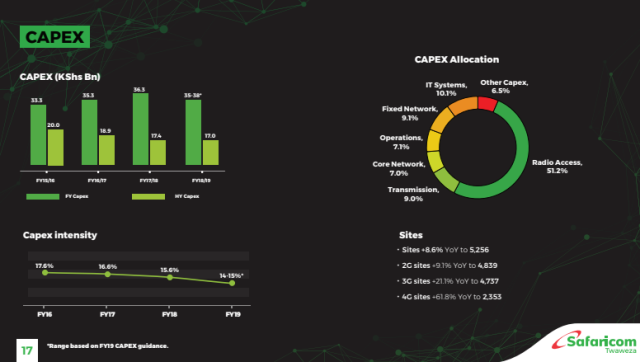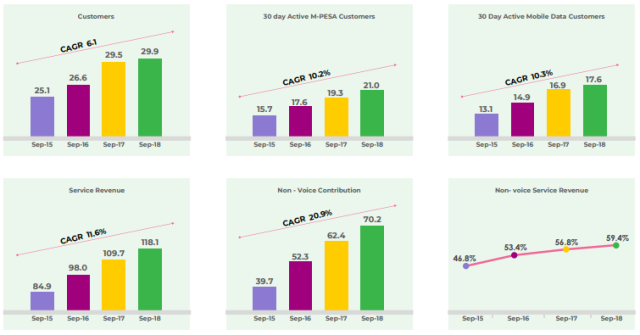Safaricom, a telecom operator in Kenya, is making investment in a 400G project to manage the growth in mobile and fixed network traffic.
Safaricom has 17.6 million data subscribers. Its FTTH network has already reached 220K homes in Kenya.
Safaricom’ mobile network traffic is estimated to increase by 6-fold and fixed network traffic 5-fold over the next three years.
Safaricom’s capital expenditure (Capex) in the network for the period ended 30 September 2018 stood at Kshs 16.98 billion.
Safaricom allocated 51.2 percent of Capex for radio access, 7 percent for core network 9 percent for transmission, 9.1 percent for fixed network 7.1 percent for operations, 10.1 percent for IT systems and 6.5 percent for other areas.
 Safaricom’s total number of sties increased 8.6 percent to 5,256. Its 2G sites rose 9.1 percent to 4,839. Its 3G sites surged 21.1 percent to 4,737. Safaricom’s 4G sites grew 61.8 percent to 2,353.
Safaricom’s total number of sties increased 8.6 percent to 5,256. Its 2G sites rose 9.1 percent to 4,839. Its 3G sites surged 21.1 percent to 4,737. Safaricom’s 4G sites grew 61.8 percent to 2,353.
Safaricom’s fibre network coverage reaches 5,500km; 3G has 91 percent coverage; 4G has 53 percent coverage;
Mobile customers have increased 1.5 percent to 29.94 million as at 30 September 2018 from 29.49 million as at 30 September 2017.

Huawei’s 400G solution
Safaricom has selected Huawei’s 400G solution for its backbone network. This is the world’s first commercial 400G project, advancing backbone network deployment towards the 400G era.
The investment in 400G backbone will replace Safaricom’s existing 100G backbone growing the capacity of network traffic carried between Mombasa, Nairobi and Kisumu to improve network reliability automation, and optimize user experiences.
Safaricom’s telecom network engineers will be building the innovative IP+optical 400G network using Huawei’s backbone router and optical transport network (OTN) platform. The backbone router provides capacity of up to 400GE per port, helping Safaricom deal with the increasing traffic on its backbone networks.

The OTN with 400G technologies doubles the transmission capacity per fiber, reducing fiber rental costs on the backbone. With fast reroute (FRR) and automatically switched optical network (ASON) technologies, the 400G solution can enable protection switching in milliseconds, said said Safaricom CTO Thibaud Rerolle.
Huawei’s 400G solution coordinates router and WDM planning and maximizes network value. The 400G solution utilizes network resources, and optimizes the forwarding cost per bit while ensuring reliability, said Jeffrey Gao, president of Huawei Router & Carrier Ethernet Product Line.
Safaricom reported that its service revenue rose 7.7 percent to Kshs 118.21 billion for the period ended 30 September 2018. Safaricom’s mobile data revenue grew 10.8 percent to Kshs 19.45 billion. M-PESA revenue of Safaricom grew 18.2 percent to Kshs 35.52 billion.
